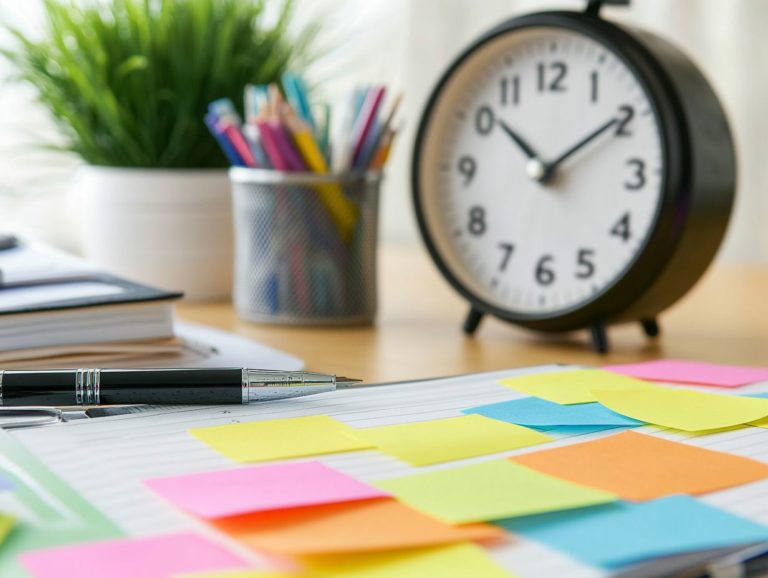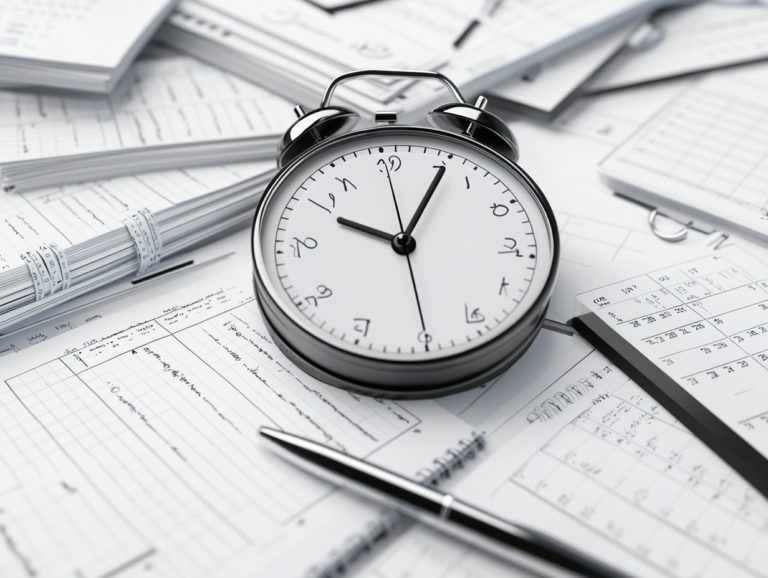How to Utilize Downtime for Productivity
In today s fast-paced world, you might find downtime feeling more like an unwelcome interruption than a valuable opportunity.
Recognizing the nuances of downtime can be transformative for your personal and professional productivity. This article delves into what downtime really means and the potential negative effects it can have if left unmanaged.
It offers insights on how to harness this time effectively, complete with practical tips and strategies designed to enhance your efficiency and reduce stress. You ll be guided in creating a customized downtime productivity plan, empowering you to navigate common obstacles along the way.
By harnessing your downtime, you can unlock new heights of productivity!
Contents
- Key Takeaways:
- Understanding Downtime and Its Impact on Productivity
- Benefits of Utilizing Downtime
- Ways to Use Downtime for Productivity
- Creating a Downtime Productivity Plan
- Overcoming Challenges in Utilizing Downtime
- Frequently Asked Questions
- What is downtime and how can it be utilized for productivity?
- How can I make the most out of my downtime to increase productivity?
- Can downtime be beneficial for productivity?
- What are some productive activities I can do during my downtime?
- How can I avoid wasting my downtime and use it for productivity instead?
- Is it important to have downtime in order to be productive?
Key Takeaways:

- Downtime is a period of inactivity or less productivity, which can negatively impact overall efficiency and stress levels.
- Utilizing downtime effectively can lead to improved efficiency and reduced stress, ultimately boosting productivity.
- To maximize your downtime, create a productivity plan by setting goals and priorities, and be ready to tackle common challenges.
Understanding Downtime and Its Impact on Productivity
In today s fast-paced, always-connected world, grasping the concept of downtime and its effects on productivity is vital for achieving a healthy work-life balance.
Downtime isn’t merely about taking breaks; it’s about strategically allowing your mind to rest and refresh, which is essential for tackling tasks effectively and engaging in focused work.
Figures like Tim Ferriss in his renowned book The 4-Hour Workweek emphasize the importance of rest and recovery in enhancing productivity.
Moreover, Cal Newport s Deep Work highlights the value of concentrated work sessions, showing how the smart use of downtime can significantly improve your mental health and creativity.
Defining Downtime and Its Negative Effects
Downtime is that precious time when you intentionally step back from work tasks. If not utilized effectively, it can lead to declines in productivity and mental health.
When you feel pressured to work longer hours, believing that more time means more output, it’s easy to overlook the critical role of quality rest and recovery. Research from the World Health Organization serves as a wake-up call: overworking can lead to burnout, affecting around 20% of employees globally. This diminishes performance and increases absenteeism and healthcare costs.
For instance, a study from Stanford University found that productivity declines significantly after a 50-hour workweek. The evidence is clear: sometimes, less truly is more. Insufficient downtime can disrupt your sleep patterns, elevate stress levels, and ultimately undermine your mental well-being. This emphasizes the necessity of incorporating structured breaks into your routine.
Benefits of Utilizing Downtime
Effectively using downtime offers numerous benefits, serving as both a powerful productivity hack and a crucial element for enhancing work-life balance and mental well-being. Engaging in activities that promote deep rest often results in a boost in creativity, sharper focus, and improved problem-solving skills.
Research indicates that those who prioritize downtime frequently report feeling more energized and motivated, significantly enhancing their overall productivity.
Improving Efficiency and Reducing Stress

Incorporating effective techniques like productive meditation and a well-timed afternoon nap can significantly elevate your efficiency while simultaneously reducing stress levels.
By strategically employing methods such as the Pomodoro Technique a time management method where you work for 25 minutes and then take a 5-minute break you can maintain laser-like focus during your work intervals. These intervals can be punctuated by short breaks for quick meditative practices or brief physical activity.
For instance, you might engage in concentrated 25-minute work sprints, followed by five minutes dedicated to deep breathing exercises. These practices can refresh your mind and boost overall productivity.
Allowing yourself a short nap can work wonders, rejuvenating your thinking ability. Studies have shown that improved concentration and creativity often follow a brief rest. These practices not only foster a sense of well-being but also contribute to greater long-term efficiency in both your personal and professional life.
Ways to Use Downtime for Productivity
You have countless opportunities to leverage downtime for enhancing your productivity. Whether you choose to embark on downtime projects or incorporate mindful practices, you can foster both mental well-being and a balanced work-life dynamic.
Practical Tips and Strategies
Implementing practical tips and strategies like the Pomodoro Technique can revolutionize your downtime into an effective productivity hack, particularly in remote work settings.
By breaking your work into manageable intervals typically 25 minutes of focused effort followed by a 5-minute break you will boost your focus and maintain momentum throughout the day. Scheduling intentional breaks creates natural pauses that recharge both your mind and body.
During these intervals, try engaging in quick stretching exercises, taking a brisk walk, or practicing mindfulness. These activities can significantly elevate your energy levels and refresh your focus.
By weaving these approaches into your daily routine, you may discover not just a remarkable boost in efficiency, but also a deeper sense of satisfaction and improved overall well-being.
Creating a Downtime Productivity Plan
Crafting a downtime productivity plan is vital for establishing clear goals and priorities that resonate with your personal aspirations and maintain a harmonious work-life balance.
This thoughtful approach fosters improved mental health by helping you identify meaningful downtime activities that refresh both your mind and body. By doing so, you ensure that you remain engaged and productive, all while skillfully avoiding the pitfalls of burnout.
Setting Goals and Priorities

Setting clear goals and priorities is crucial for anyone aiming to optimize their downtime and boost overall productivity.
When you take the time to define what truly matters to you, you can create actionable objectives that not only utilize your free hours but also resonate with your core values.
By identifying these personal values, you can effectively sift through various activities and focus on those that bring you genuine fulfillment. This alignment cultivates a deeper sense of purpose, enabling you to achieve a more harmonious work-life balance.
Engaging in meaningful pursuits during your leisure time has been shown to significantly enhance mental health, reducing stress and increasing overall satisfaction. Therefore, crafting well-defined goals can transform your downtime into a valuable opportunity for personal growth and rejuvenation.
Overcoming Challenges in Utilizing Downtime
While leveraging downtime for productivity can be advantageous, navigating challenges is crucial for truly reaping its benefits. Numerous common obstacles can impede effective rest and recuperation, making it essential to address them head-on.
Common Obstacles and How to Overcome Them
Some common obstacles you might face when trying to effectively utilize downtime include distractions, guilt over taking breaks, and the challenge of prioritizing self-care especially in a remote work environment. Making self-care a priority is crucial, but it can be challenging!
These challenges can lead to unproductive stretches where you struggle to recharge, ultimately affecting your work performance and mental health. Distractions may arise from the relentless buzz of notifications or household chores, making it easy for you to lose focus. Guilt often creeps in when you view downtime as a weakness, leading to overwork and burnout.
In a home office setting, the boundaries between work and personal life start to blur, making it hard to prioritize self-care. A successful strategy involves setting designated break times and crafting a dedicated workspace to minimize distractions.
For example, you can use a time management method that employs short work intervals followed by breaks, which helps harmonize work and rest effectively.
Incorporating mindfulness practices, such as brief meditation sessions, can significantly alleviate feelings of guilt and boost your overall well-being.
Frequently Asked Questions
What is downtime and how can it be utilized for productivity?

Downtime refers to periods when you are not actively engaged in work or other activities. It can be utilized for productivity by accomplishing tasks, learning new skills, or simply recharging and relaxing.
How can I make the most out of my downtime to increase productivity?
One effective way to maximize your downtime is to create a to-do list or schedule beforehand. This helps you prioritize and focus on specific tasks, making your downtime more productive.
Can downtime be beneficial for productivity?
Absolutely! Downtime can be extremely beneficial for productivity. It allows your mind and body to rest and recharge, leading to increased focus and creativity when you return to work.
What are some productive activities I can do during my downtime?
Some productive activities you can engage in during downtime include reading, learning a new skill or language, organizing your workspace, or participating in hobbies or physical activities.
How can I avoid wasting my downtime and use it for productivity instead?
To avoid wasting downtime, set clear boundaries and stick to a schedule. This prevents distractions and keeps you focused on using your downtime productively.
Is it important to have downtime in order to be productive?
Yes, having downtime is crucial for productivity. Constantly working without breaks can lead to burnout and decreased effectiveness. Downtime allows for rest and rejuvenation, which is essential for maintaining productivity long-term.





